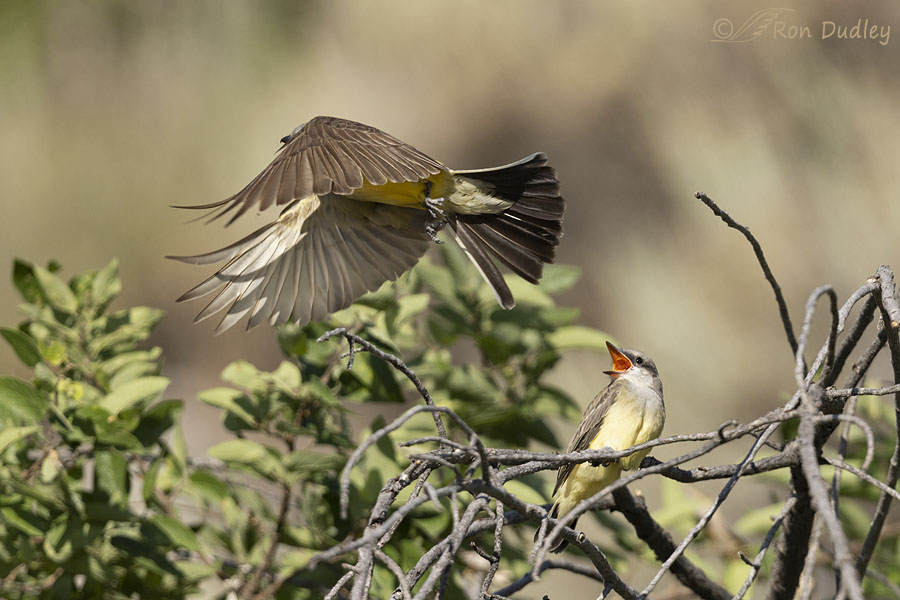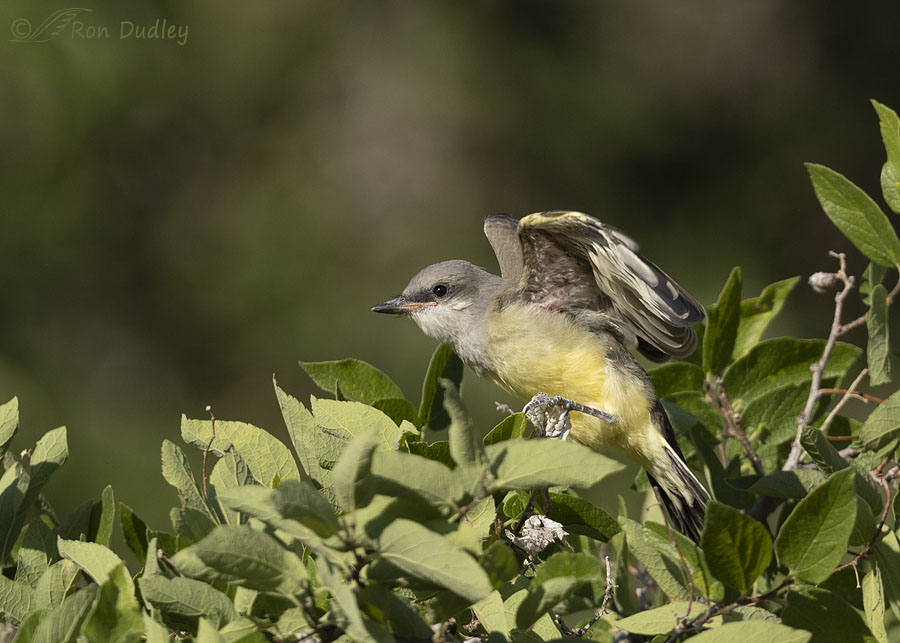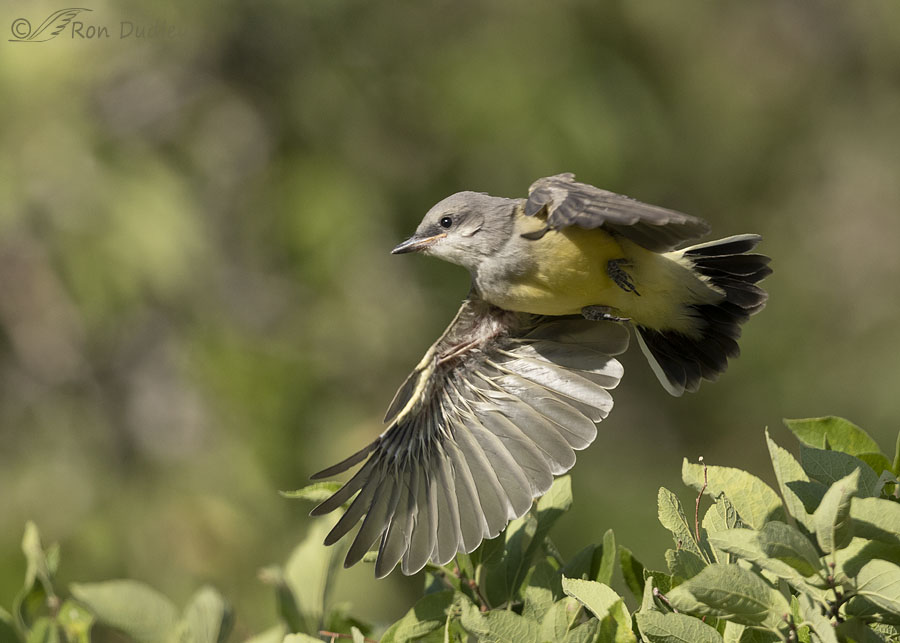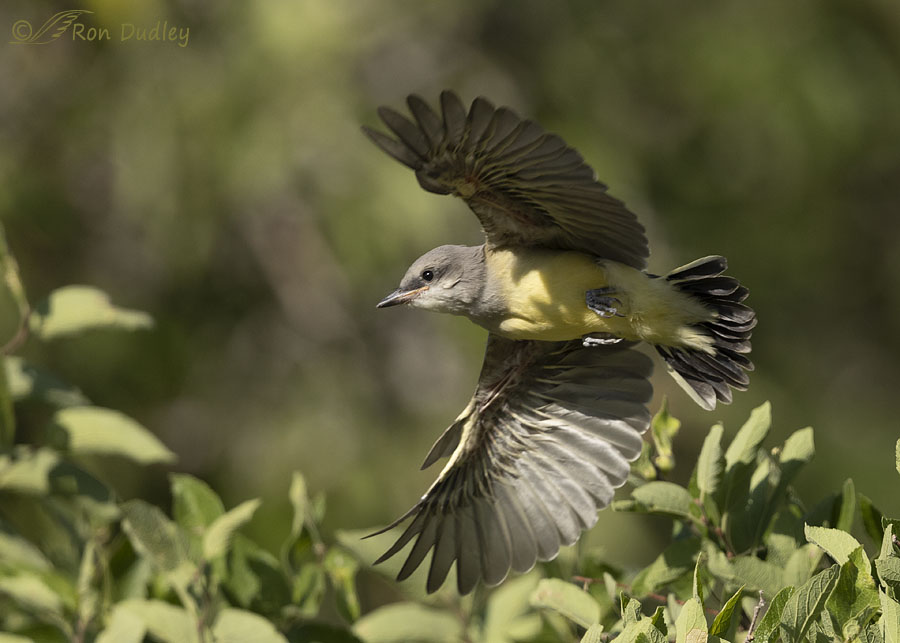Yesterday morning I finally got out again and actually found some birds, including a fun encounter with a family of Western Kingbirds.

1/4000, f/6.3, ISO 800, Canon R5, Canon EF500mm f/4L IS II USM + 1.4 tc, not baited, set up or called in
There were four of them, two recent fledglings and their parents. And man, were they ever noisy. Based on the racket they made you’d think the youngsters were on the verge of starvation.
Most of the time the fledglings would wait on a branch in one of the adjacent bushes for the adults to deliver food to them but occasionally they followed their parents around, making an absolute nuisance of themselves as they did so.
Here the fledgling on the right is reacting to its parent flying off after a food delivery. Mostly I’m including this photo to give readers a feeling for the pandemonium that was occurring as the adults tried to appease their hungry offspring. It’s the only shot I got with more than one bird in the frame where both birds were sharp.
The following three photos are sequential without any skips.

1/3200, f/6.3, ISO 800, Canon R5, Canon EF500mm f/4L IS II USM + 1.4 tc, not baited, set up or called in
The fledglings were old enough to fly, probably to the regret of their parents because if they’d stayed in one place they’d have been a lot easier to keep fed. I caught this youngster just prior to takeoff.
Notice the bald spot in its ‘armpit’ where the axillaries haven’t grown in yet – one of the indicators of its tender age. Another such indicator is its prominent gape (see note below).

1/3200, f/6.3, ISO 800, Canon R5, Canon EF500mm f/4L IS II USM + 1.4 tc, not baited, set up or called in
The next photo in the burst.

1/4000, f/6.3, ISO 800, Canon R5, Canon EF500mm f/4L IS II USM + 1.4 tc, not baited, set up or called in
This is the last shot I got where the fledgling was sharp enough. I have a fourth one but in that photo the bird is just too soft. In this photo there’s a third indicator of the young age of the bird. Can you spot it?
Notice how short and stubby its tail is. Those tail feathers haven’t yet reached their mature length.
I had a blast yesterday, with these kingbirds and others. I thoroughly enjoyed the remoteness of my location, the resulting solitude (in 3 1/2 hours I only saw one other vehicle on the road) and of course the birds and mammals I encountered. I arrived on location before sunrise so it was also my favorite part of the day – very early morning.
It reminded me of what I’ve been missing while I’ve been stuck at home for various reasons.
Ron
Note:
“Gape: This is a fleshy area at the base of the bill where the upper and lower mandibles meet. In young birds, it is often enlarged or may seem so because the birds have not developed their mature feathers to help conceal it, and it may be brightly colored so their mouths are more noticeable when they beg for food.”


They may not be flashy, but they do have colors, don’t they. Love the gape. I’ve raised a few nestlings so I am familiar with that and the whine!!! I mean peeping.
Arwen, they may not have flashy colors but they make up for it in personality.
Congratulations on getting out again! I can imagine how good that felt.
These are great photos that capture the excitement found in seeing fledglings get their start in life. I particularly like the bright pink/red mouth in the first photo. It demonstrates how effective the coloration is for getting the parents’ attention.
Thanks very much, Julie.
What an absolutely delightful start to your day – and now to mine.
Mind you, in the predawn quiet here I am glad not to hear them.
And, as others have said, I have no doubt that the parents are as frustrated, annoyed and often worried as our species is when the young ‘uns start to walk…
EC, actually I started my day, minutes before dawn, with a very cooperative Short-eared Owl. You’ll be seeing photos of that bird sometime soon.
Oooooh.
I’m glad they were noisy so you noticed them … what joy to see these images of a Western Kingbird-in-training, such a beautiful little creature! That big, bright orange open mouth in the first photo is adorable, though the harried parent no doubt has a different opinion of it. Glad you enjoyed your early-morning commune with nature!
It was a wonderful morning in almost every way, Chris. Except for the long drive home in the building heat.
Lovely photos, the flight images are wonderful with detail of the young birds feathering. You must have left very early to make it to your destination at dawn, that is not a short drive. I have not been for almost a year. Mostly due to the distance and amount of time sitting. It takes about 6 hours round trip!
Yup, it was an early morning. Got up not long after 2, got my blog post published and left the house at 5:10 AM.
Which explains why I had a nearly 3 hour nap yesterday afternoon!
Nice peek at the radius and ulna before they are feathered over.
Not ever having seen or heard Western Kingbirds, I wonder if the cacophony they make is to predators what my reaction is to death metal “music”: extreme avoidance.
Lyle, it’s my guess that predators react to it like they would to a dinner bell. Get’s the ol’ predatory juices flowing.
So glad you had a good day. Wonderful images of these fierce characters. I get to watch several families of them every year and they keep me smiling. It’s amazing how vocal the demanding youngsters are.
“Vocal” is their middle name, adults and youngsters. Thanks, Ann.
Sensational series Ron!
Thanks for sharing!
Charlotte Norton
Thanks, Charlotte.
Excellent and fun photos of these youngsters. I have often observed this behavior over the years and as you say here they do make a nuisance of themselves as they noisily follow their parents around for food. I always wonder how the parents can remember who’s been fed and who has not.
Glad you had such a nice morning.
Everett, I doubt they remember. Which one clamors the loudest and most aggressively is the hungriest, would be my guess.
Interesting photos. Even the primaries and secondary’s appear to have some filling in to do.
Michael, I think it’s interesting that in most birds the wing flight feathers develop faster than tail feathers, suggesting that early flight has a positive influence on their survival. Makes sense.
I have wondered if the tail feathers come in later to protect them. Early flight and ground sitting is really hard on the tail feathers, the wear and damage, possibly breaking . The feathers will not regrow unless pulled from the folicule. So a bird would be stuck with poor tail feather til the next molt.
That could definitely be part of it, April.
I’m so happy for you to at last go out and be surrounded by what you love so passionately ! New term today for me–“gape”—thanks .
You’re welcome, Kris. Based on your feedback I’m glad I included it.
Wonderful way to spend the morning! Busy, pretty Western King Birds. I haven’t noticed any here this year tho we do have a few Eastern. Bird population is very low both in variety and numbers for this time of year. ;(
Sounds like human parents excited when their kids start walking and…………
Judy, your last sentence brought back memories of Shannon when she first started walking, oh so many years ago. What a handful!
Sounds like Shannon was probably your “just deserts”…….
Mom always said so. I’ve never understood why…
Nice!
Thanks.
The short tail was the most obvious fledgling characteristic to me, probably because it is the one I see most often with 8X binoculars.
The constant begging and noise makes me sorry for the harried parents sometimes.
Pam, these kingbirds were making so much noise it made me wonder why such behavior isn’t selected against because of predators it’s likely to attract.
It sure attracted me. If they hadn’t been making such a fuss I’d never have noticed them.